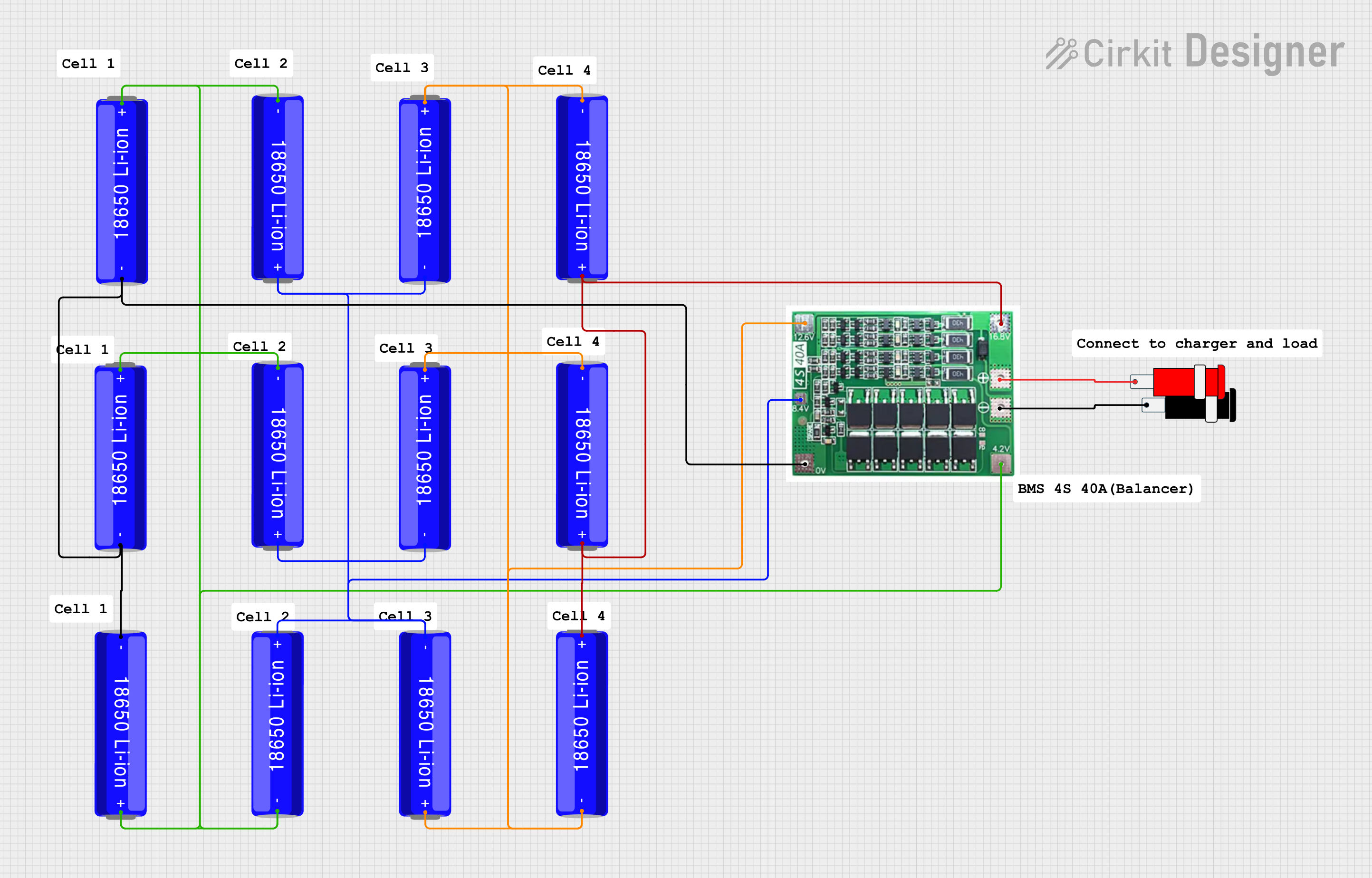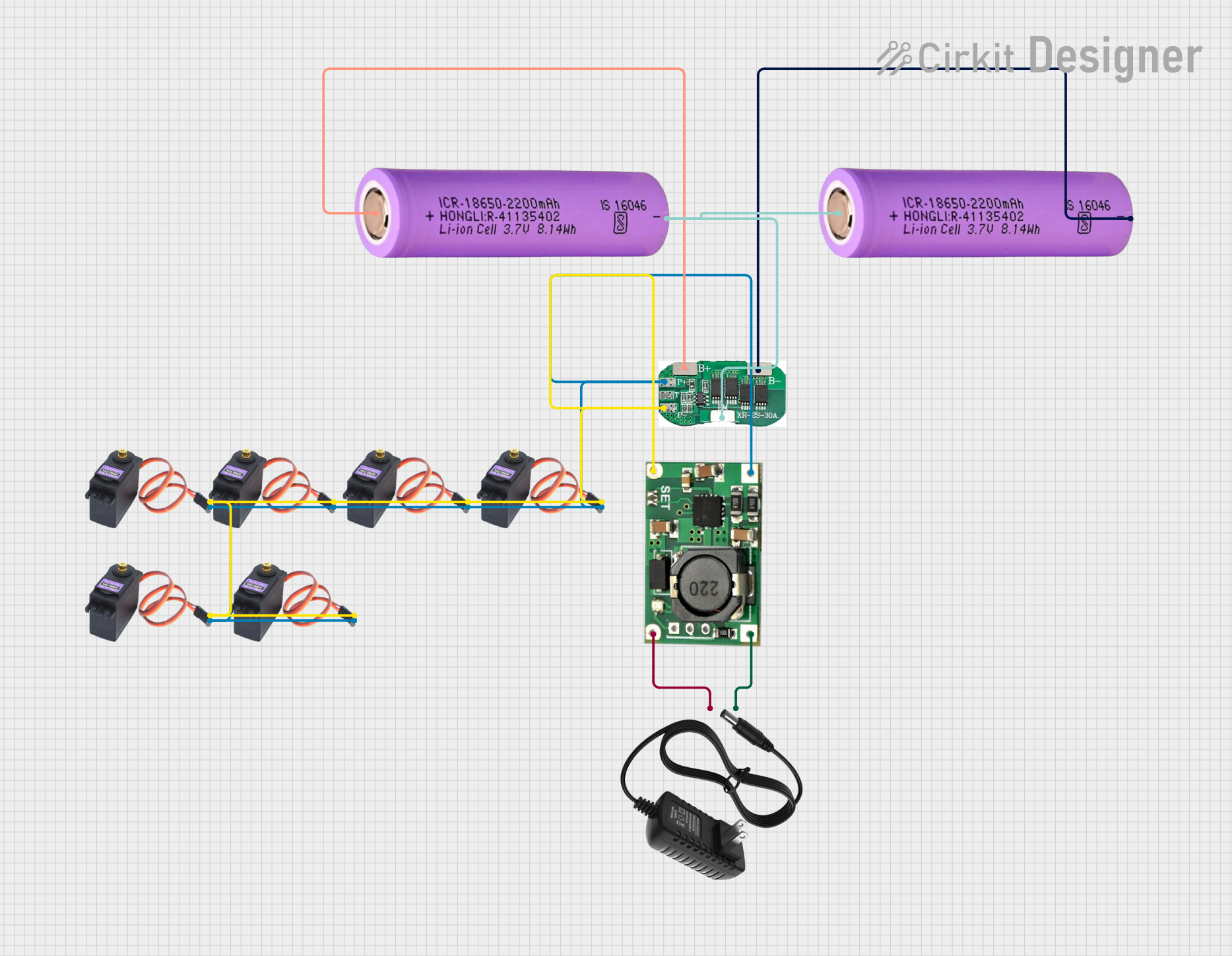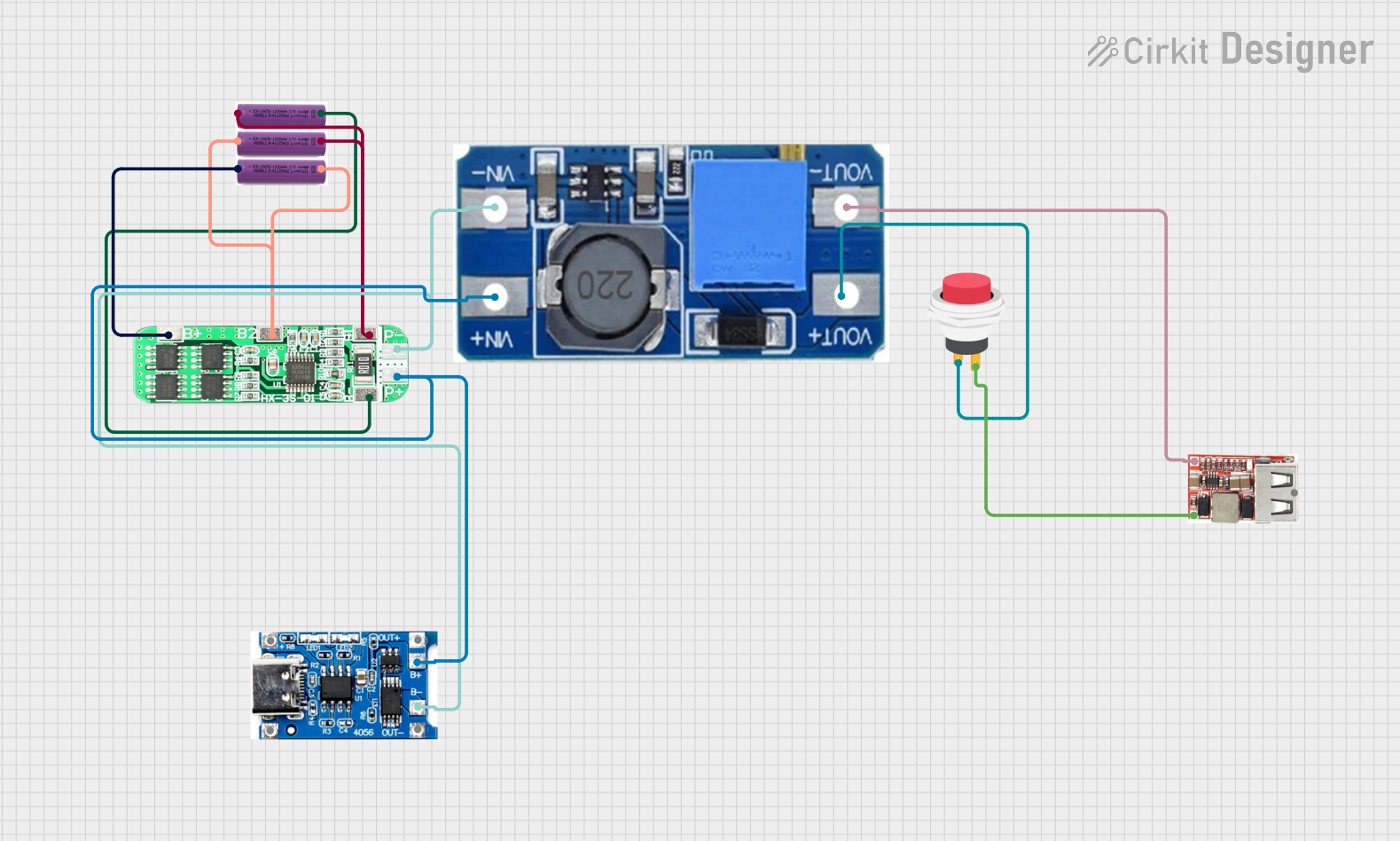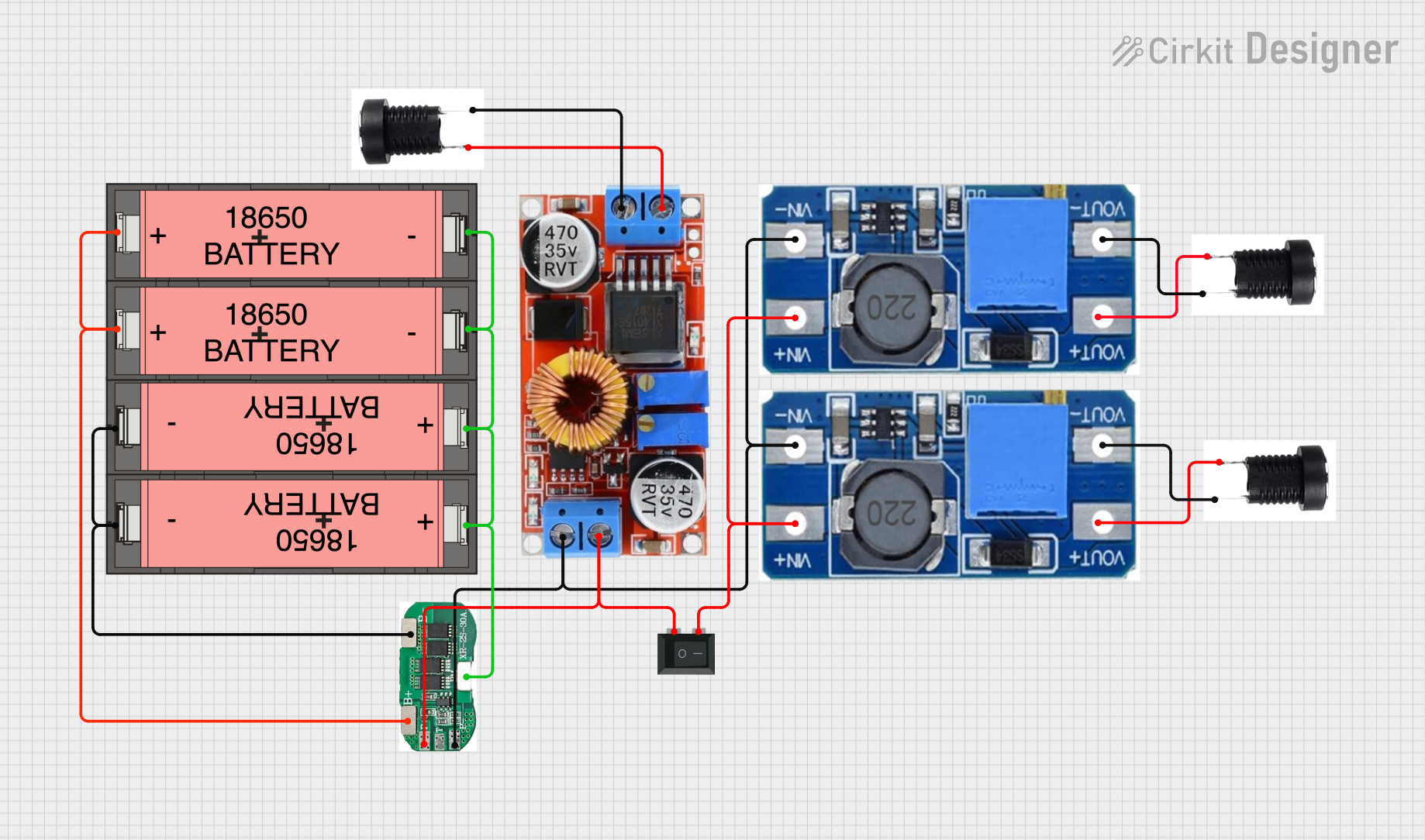
How to Use 3S BMS: Examples, Pinouts, and Specs

 Design with 3S BMS in Cirkit Designer
Design with 3S BMS in Cirkit DesignerIntroduction
A 3S Battery Management System (BMS) is a crucial component used to monitor and manage the charging and discharging of a 3-cell lithium battery pack. It ensures the safety of the battery pack by preventing overcharging, over-discharging, and short circuits. Additionally, it helps in extending the battery life by balancing the charge across the cells.
Explore Projects Built with 3S BMS

 Open Project in Cirkit Designer
Open Project in Cirkit Designer
 Open Project in Cirkit Designer
Open Project in Cirkit Designer
 Open Project in Cirkit Designer
Open Project in Cirkit Designer
 Open Project in Cirkit Designer
Open Project in Cirkit DesignerExplore Projects Built with 3S BMS

 Open Project in Cirkit Designer
Open Project in Cirkit Designer
 Open Project in Cirkit Designer
Open Project in Cirkit Designer
 Open Project in Cirkit Designer
Open Project in Cirkit Designer
 Open Project in Cirkit Designer
Open Project in Cirkit DesignerCommon Applications and Use Cases
- Electric Vehicles (EVs): Ensures safe and efficient battery usage.
- Portable Electronics: Used in devices like laptops and power banks.
- Renewable Energy Systems: Manages battery packs in solar and wind energy systems.
- RC Models and Drones: Provides reliable power management for high-performance applications.
Technical Specifications
Key Technical Details
| Parameter | Value |
|---|---|
| Battery Configuration | 3S (3 cells in series) |
| Input Voltage Range | 9V - 12.6V |
| Overcharge Voltage | 4.25V ± 0.05V per cell |
| Over-discharge Voltage | 2.5V ± 0.1V per cell |
| Maximum Continuous Current | 20A |
| Balance Current | 60mA |
| Operating Temperature | -40°C to 85°C |
Pin Configuration and Descriptions
| Pin Number | Pin Name | Description |
|---|---|---|
| 1 | B- | Battery negative terminal |
| 2 | B1 | Connection to the first cell |
| 3 | B2 | Connection to the second cell |
| 4 | B3 | Connection to the third cell |
| 5 | B+ | Battery positive terminal |
| 6 | P- | Power output negative terminal |
| 7 | P+ | Power output positive terminal |
Usage Instructions
How to Use the Component in a Circuit
Connect the Battery Pack:
- Connect the negative terminal of the battery pack to the B- pin.
- Connect the positive terminal of the first cell to the B1 pin.
- Connect the positive terminal of the second cell to the B2 pin.
- Connect the positive terminal of the third cell to the B3 pin.
- Connect the positive terminal of the battery pack to the B+ pin.
Connect the Load/Charger:
- Connect the negative terminal of the load/charger to the P- pin.
- Connect the positive terminal of the load/charger to the P+ pin.
Important Considerations and Best Practices
- Ensure Proper Connections: Double-check all connections to avoid short circuits.
- Use Appropriate Wire Gauges: Use wires that can handle the maximum current rating.
- Monitor Temperature: Ensure the BMS operates within the specified temperature range.
- Balance Charging: Regularly balance charge the battery pack to maintain cell health.
Troubleshooting and FAQs
Common Issues Users Might Face
BMS Not Powering On:
- Solution: Check all connections and ensure the battery pack is properly connected.
Overcharge/Over-discharge Protection Triggering Frequently:
- Solution: Verify the cell voltages and ensure they are within the specified range.
Uneven Cell Voltages:
- Solution: Perform a balance charge to equalize the cell voltages.
Excessive Heat Generation:
- Solution: Ensure proper ventilation and check for any short circuits.
FAQs
Q1: Can I use the 3S BMS with a different battery configuration?
- A1: No, the 3S BMS is specifically designed for 3-cell lithium battery packs.
Q2: How do I know if the BMS is balancing the cells?
- A2: The BMS will automatically balance the cells when the voltage difference exceeds a certain threshold.
Q3: Can I connect the BMS directly to an Arduino UNO?
- A3: The BMS is not directly interfaced with an Arduino UNO. However, you can monitor the battery pack's voltage and current using appropriate sensors and interface them with the Arduino.
Example Code for Monitoring Battery Voltage with Arduino UNO
// Example code to monitor battery voltage using Arduino UNO
// Connect the voltage divider output to A0 pin of Arduino
const int voltagePin = A0; // Pin connected to voltage divider
float voltage = 0.0;
void setup() {
Serial.begin(9600); // Initialize serial communication
}
void loop() {
int sensorValue = analogRead(voltagePin); // Read the analog value
voltage = sensorValue * (5.0 / 1023.0) * 3; // Convert to voltage
// Multiply by 3 to account for the voltage divider ratio
Serial.print("Battery Voltage: ");
Serial.print(voltage);
Serial.println(" V");
delay(1000); // Wait for 1 second before next reading
}
This code reads the voltage from a voltage divider connected to the battery pack and prints it to the serial monitor. Adjust the voltage divider ratio as needed for accurate readings.
This documentation provides a comprehensive guide to understanding, using, and troubleshooting the 3S Battery Management System (BMS). Whether you are a beginner or an experienced user, this guide aims to help you make the most of your BMS.